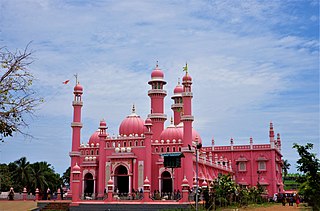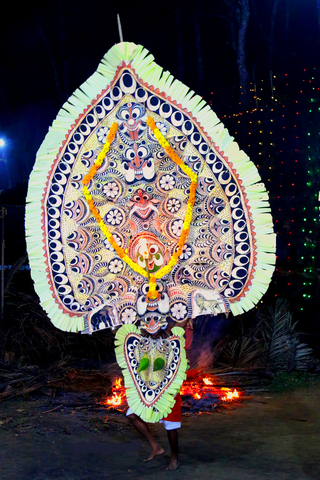The music of Trinidad and Tobago is best known for its calypso music, soca music, chutney music, and steelpan. Calypso's internationally noted performances in the 1950s from native artists such as Lord Melody, Lord Kitchener and Mighty Sparrow. The art form was most popularised at that time by Harry Belafonte. Along with folk songs and African- and Indian-based classical forms, cross-cultural interactions have produced other indigenous forms of music including soca, rapso, parang, chutney, and other derivative and fusion styles. There are also local communities which practice and experiment with international classical and pop music, often fusing them with local steelpan instruments.

Yakshagana is a traditional theatre, developed in Dakshina Kannada, Udupi, Uttara Kannada, Shimoga and western parts of Chikmagalur districts, in the state of Karnataka and in Kasaragod district in Kerala that combines dance, music, dialogue, costume, make-up, and stage techniques with a unique style and form. It is believed to have evolved from pre-classical music and theatre during the period of the Bhakti movement. It is sometimes simply called "Aata" or āṭa. This theatre style is mainly found in coastal regions of Karnataka in various forms. Towards the south from Dakshina Kannada to Kasaragod of Tulu Nadu region, the form of Yakshagana is called Thenku thittu and towards the north from Udupi up to Uttara Kannada it is called Badaga thittu. Both of these forms are equally played all over the region. Yakshagana is traditionally presented from dusk to dawn. Its stories are drawn from Ramayana, Mahabharata, Bhagavata and other epics from both Hindu and Jain and other ancient Indic traditions.

The Malayali people are a Dravidian ethnolinguistic group originating from the present-day state of Kerala & Union Territory of Lakshadweep in India, occupying its southwestern Malabar coast. They form the majority of the population in Kerala and Lakshadweep. They are predominantly native speakers of the Malayalam language, one of the six classical languages of India. The state of Kerala was created in 1956 through the States Reorganisation Act. Prior to that, since the 1800s existed the Kingdom of Cochin, the Kingdom of Travancore, Malabar District, and South Canara of the British India. The Malabar District was annexed by the British through the Third Mysore War (1790–92) from Tipu Sultan. Before that, the Malabar District was under various kingdoms including the Zamorins of Calicut, Kingdom of Tanur, Arakkal kingdom, Kolathunadu, Valluvanad, and Palakkad Rajas.
Marthandam is a major trade centre in Kuzhithurai municipality across National Highway in the Kanyakumari district of Tamil Nadu, India. Formerly known as Thoduvetty, it was a portion of Kanyakumari district which was added to the state of Tamil Nadu on 1 November 1956.

Poorakkali is a traditional dance ritual performed by men during the nine-day Pooram festival in Bhagavathy temples across North Malabar in Kerala State of south India.

Oppana is a popular form of social entertainment among the Mappila community of Kerala, South India, prevalent throughout Kerala, especially in Malabar. The term Oppana is believed to be originated from the Arabic word "Affna". Oppana is traditionally used in various important cultural ceremonies, and in particular, is a component of all Mappila weddings. In Kerala, this art form has been revived with much popularity on the performing stages of the Youth Festivals of the student community.

The culture of Kerala has developed over the past millennia, influences from other parts of India and abroad. It is defined by its antiquity and the organic continuity sustained by the Malayali people. Modern Kerala society took shape owing to migrations from different parts of India and abroad throughout Classical Antiquity.

The Indian state Kerala is well known for its diverse forms of performing arts. The various communities in Kerala contribute to its rich and colourful culture. The most important traditional art forms of Kerala are Kathakali, Kalaripayattu,Mayilpeeli Thookkam, Koodiyattam, Theyyam, Mohiniyattam, Thullal, Padayani, Pulikali, Thiruvathirakali, Chakyarkoothu,Chavittunadakam, etc.
The dance forms of Andhra Pradesh take on a wide variety of colors, costumes, and types; and involve different settings and musical instruments.

Maranchery is a census town within the circle of Ponnani taluk, Malappuram district, in the Indian state of Kerala.

Islam arrived in Kerala, the Malayalam-speaking region in the south-western tip of India, through Middle Eastern merchants. The Indian coast has an ancient relation with West Asia and the Middle East, even during the pre-Islamic period.
Kummi is a folk dance, popular in Tamil Nadu and Kerala in India, danced mostly by South Indian women in circle. Dancing may be different. In some places, it is very simple, with rhythmic clapping or beating of the drums. In other places dancers imitate various harvesting activities. Kummi often accompany by songs, called "Kummi songs". It is often danced during festivals. It is also danced by Tamils of Sri Lanka. Kummi songs became a popular addition to kuthiyottam festivities in modern times.

Beemapally is a region within the city of Thiruvananthapuram in the state of Kerala, India. Beemapally is famous for its mosque, Beemapally Dargah Shareef, which houses the tomb of Syedunnisa Beema Beevi, a woman believed to have divine powers, and her son Syedu Shuhada Maheen Abubacker. Every year there is a festival held to venerate Beema Beevi which attracts thousands of pilgrims from all faiths and castes. The tomb of Beema Beevi, the lady with miraculous powers who is believed to belong to the Prophet Mohammed’s family, is located at the mosque.

Aravana muttu or arabana muttu is an art form prevalent among Muslims in Kerala state of south India, named after the aravana, a hand-held, one-sided flat tambourine or drumlike musical instrument, derived from Arabia. It is made of wood and animal skin, similar to the duff but a little thinner and bigger. In the opinion of Becker Edakkazhiyur, a noted arabana musician, "the ritualistic performance of `Arabana Reefa Ee Raathib Muttu' has been mistaken for `Arabana Kali Muttu,' which is purely for entertainment. While the former is almost extinct, the latter, known for its aesthetic appeal, is the one presented nowadays."

Padayani, also known Padeni, is a traditional folk dance and a ritual art from the central portion of the Indian state of Kerala. A ceremonial dance involving masks, it is an ancient ritual performed in Bhagavati temples. The dance is performed in honor of Bhadrakaali. Meaning, a 'row of warriors', Padayani is an art form that blends all music, dance, theatre, satire, facial masks, and paintings. It is part of worship of Bhadrakali and is staged in temples dedicated to the goddess from mid-December to mid-May. Padayani is unique to central Travancore, comprising the Pathanamthitta and Kottayam districts of Kerala. It is also performed in adjoining regions of Kollam, Alappuzha districts.
Poongode is a small village in Kalikavu Panchayat, Nilambur taluk in Malappuram district in the state of Kerala. Nethaji arts&sport club is one of the oldest football teams. The peoples are unique with co-operation. The majority are Muslims and Hindus. G.L.P school poongode is situated 300 meters from town with a football stadium.

The MajorVellayani Devi Temple is a highly revered shrine in Kerala, India, dedicated to goddess Bhadrakali. The shrine is situated in Vellayani 1.5 km west of Vellayani junction, 12 km southeast of Thiruvananthapuram on the eastern bank of Vellayani Lake. The temple is under the management of Travancore Devaswom Board. The temple structure has a bronze roof with traditional art work and carries Dravidian architecture. The temple has eastern and northern towers called Gopurams with statues of different Gods sculptured in them. The Gopurams function as gateways through the walls that surround the temple complex.
Ambalakkadavu is a village in Kalikavu. It is located in the north of Kerala state.

Thirayattam is a ritualistic art form that is performed annually in the South Malabar region of the Indian state of Kerala. It is a tribal art form that combines dance, acting routines, songs, instrumental music, face writing, martial arts and rituals.


















